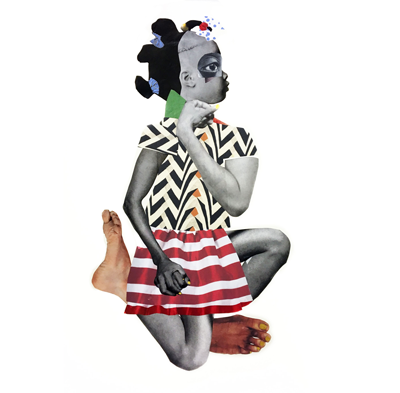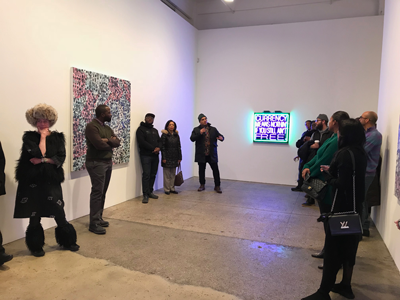NEW YORK, Jan. 9. – Beginning the New Year, 2018
By Barbara T. Hoffman
With most tourists gone and new gallery exhibitions, the first week in January is a time to catch museum exhibitions soon to close, and visit Chelsea.
A highlight of last week was a great outing with MoMA’s Friends of Education to Sidelined at Galerie Lelong, a group exhibition curated by Samuel Levi Jones. Inspired by the recent protests of NFL players during the national anthem, Sidelined brings together artists responding to injustices experienced by people of color both on and off the sports field: Melvin Edwards, Derek Fordjour, Lauren Halsey, David Huffman, Samuel Levi Jones, Glenn Kaino, Patrick Martinez, and Deborah Roberts. The artists pose urgent questions about the systems of power that can devalue the lives of minorities in the United States.
“Derek Fordjour’s new paintings explore the competitive game as a metaphor for the stratification of identity within American democracy: a system of reward and punishment, spectacle versus spectator.” By coincidence, Derek was the 2016-2017 Artist in Residence at the Sugar Hill Children’s Museum of Art and Storytelling and has an exhibition as a result entitled PARADE. PARADE takes visitors on a journey through the sense-memory of childhood and the process of forging an identity, and reflects back to Fordjour’s own curiosities, observations, and obsessions as a child artist growing up in Memphis, Tennessee. It is on view until February 2018. As Faith Ringgold’s lawyer, I was involved with the setting up of that museum, which was originally to be called the Faith Ringgold Museum of Art and Storytelling. Faith decided for a variety of reasons not to participate in the project. See http://www.nytimes.com/2012/02/13/arts/faith-ringgold-withdraws-support-from-harlem.html. It is nice to see that despite concerns, artists of Derek’s qualifications and talent are involved with the museum and willing to commit to the time and effort required for a residency and exhibition. Here I am standing next to Derek in front of David Huffman’s work.
Huffman continues his ongoing investigation into “social abstraction by repeating a kneeling figure of Colin Kaepernick across wood panel, recalling how the Black Panther logo itself was also urgently replicated.” Huffman’s mother was an artist with the Black Panthers in 1969 in Oakland. “Questioning what progress has been made for minorities, Huffman intentionally fades the colors of red, white, and blue in his work to suggest a democracy diminished.”
Patrick Martinez in the photo is explaining that his neons illuminate the racial overtones of NFL team mascots and logos. So far it appears, he has received no cease and desist letters.
I first discovered Roberts’ powerful work at Volta in 2016. Deborah Roberts’s O! say can’t you see (2017) features a young girl kneeling in protest. Her figure is composited of images such as Michelle Obama’s fists and James Baldwin’s eye. Martinez and Roberts can be seen at Fiction at the Studio Museum, the fifth in its series of emerging African American artists which began with Free Still in 2001. Roberts’ work is on the cover of the fall/winter magazine for the Studio Museum. Great news – Fiction has been extended until January 15. Don’t miss it.

© Deborah Roberts, O’Say Can’t you See?, 2017. Mixed media on paper, 30 x 22 inches (76.2 x 55.9 cm). Photo: Christopher Burke. Courtesy Galerie Lelong & Co., New York
The exhibition will be on view during Super Bowl LII, scheduled to be played on February 4, 2018.
I also caught Gates of Paradise – Part 2, the second installment of Hiroshi Sugimoto’s beautifully installed exhibition at Japan Society. Several recent exhibitions have focused on cross-cultural interactions in earlier periods of history; the rather controversial attempt by Damien Hirst in Treasures from the Wreck of the Unbelievable at the Palazzo Grassi in Venice in 2017 and the exhibition at Asia Society, Secrets of the Sea: A Tang Shipwreck and Early Trade in Asia (2017), to mention two. In my own research and legal practice as a lawyer, I have been doing work on the nautical silk road and assisting a number of expeditions and colleagues from the Explorer’s Club on the legal issues related to archeological finds off the coast of Indonesia. See /wp-content/uploads/sites/1303402/2020/03/wp-content/uploads/sites/1303402/2020/03/Article_Sailing-on-Uncharted-Waters.pdf. In fact, that was the purpose of my trip to Amersfoort this summer, which was the subject of another diary entry. See https://www.oneartnation.com/the-art-lawyers-diary-by-barbara-hoffman-grand-tour-documenta-14-skulptur-projekte-2017-mondrian/.
” Hiroshi Sugimoto: Gatesof Paradise focuses on one of the most remarkable stories to emerge from this era-that of the Tenshō Embassy. In 1542, four boys were dispatched to Europe by Christian daimyō (samurai lords) to experience Christianity in the West and to represent the success of the Jesuit Mission in Japan. After a two-and-a-half year sea voyage, the boys-named Mancio Ito, Miguel Chijiwa, Juliao Nakuara, and Martinao Hara-arrived in Lisbon, Portugal, becoming the first Japanese emissaries to the Western World. They were fêted at the courts of princes and popes and toured some of the grandest monuments of Iberia and Italy, before returning to Japan in 1590.
The exhibition charts the boys’ European sojourn through Sugimoto’s vast, meticulously created black-and-white photographs of sites that they visited, including the world premiere of his newest series capturing Lorenzo Ghiberti’s renowned relief panels of Biblical scenes-known commonly as the “Gates of Paradise”-which the boys are believed to have seen while in Florence. The photographic sections are interspersed with treasures of Momoyama- and early Edo-period art, including vibrant nanban paintings which synthesize the Japanese and European artistic traditions.
© Barbara Hoffman



